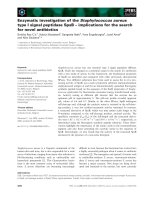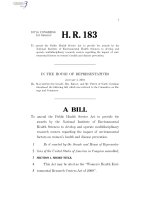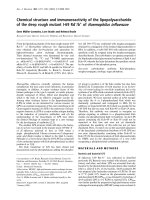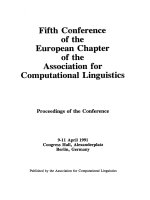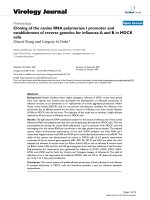ESSENTIALS OF ENVIRONMENTAL HEALTH
Bạn đang xem bản rút gọn của tài liệu. Xem và tải ngay bản đầy đủ của tài liệu tại đây (1.12 MB, 95 trang )
i
ACKNOWLEDGEMENT
I couldn’t complete my graduation paper without the invaluable help, advice,
and encouragement of my beloved teachers, friends and family.
First of all, I would like to express my deepest gratitude to Mr. Tran Huu Hung my respectable teacher who teaches and supports me a lot during my graduation
paper. He spent his highly valuable time giving me the guidance, encouragement
and suggestions so that I can complete the graduation paper successfully.
Without his help, I am not sure I can complete it on time.
I would like to express my deep gratitude to teacher Tran Huu Hung for
everything he has done for me.
Secondly, I would like to give special thanks to my teachers of Foreign
Languages Department of Duy Tan University for teaching me helpful
specialized knowledge and necessary skills so that we can develop our abilities.
Thank you so much!
Thirdly, I want to take this opportunity to say thank to my dear friends who not
only shared their useful experiences but also helped me solve difficulties during
my study and my research work as well.
Finally, I wish to thank my family for their support, encouragement and
motivation they gave me on completion of this graduation paper.
I hope to receive the sympathy from teachers because of the shortcomings in this
graduation.
I wish all of you good health and success!
Yours sincerely!
Supervisor: Tran Huu Hung
Nguyen Thi Thu Ha-1920316306
ii
STATEMENT OF AUTHORSHIP
There had not been any published Vietnamese edition of the book containing the
translated chapter until I started working on my graduation paper. My
graduation paper also doesn’t copy any parts of content in other graduation
papers in any universities. It uses information from other chapters in the same
book.
Any source of references is cited and acknowledged in the REFERENCES.
This graduation paper has not been submitted for award of any degree or
diploma in any other tertiary institution.
Danang, February 5th, 2017
NGUYEN THI THU HA
Supervisor: Tran Huu Hung
Nguyen Thi Thu Ha-1920316306
iii
ABSTRACT
This graduation paper is about environmental field. I translate chapter 10 (from
English
into
Vietnamese)
named:
“AIR
QUALITY”
of
the
book:
“ESSENTIALS OF ENVIRONMENTAL HEALTH”. Besides, I also analyze
some necessary issues such as vocabulary and structure in this chapter. In
addition, through this graduation paper, I myself find out some difficulties that I
and other students fell confused in environmental translation and put forward
some effective solutions.
Supervisor: Tran Huu Hung
Nguyen Thi Thu Ha-1920316306
iv
ABBREVIATIONS
WHO: World Health Organization
e.g: Exampli gratia
NOX: Nitrogen oxide
SO2: Sulfur dioxide
VOCS: Volatile organic compounds
CO: Carbon monoxide
PM: Particulate matter
AQI: Air Quality Index
NAAQS: National Ambient Air Quality Standard
EPA:
Environmental
Supervisor: Tran Huu Hung
Protection
Agency
Nguyen Thi Thu Ha-1920316306
Table of Contents
ACKNOWLEDGEMENT ........................................................................................................... i
STATEMENT OF AUTHORSHIP ............................................................................................ ii
ABSTRACT ..............................................................................................................................iii
ABBREVIATIONS ................................................................................................................... iv
PART A ...................................................................................................................................... 1
INTRODUCTION ...................................................................................................................... 1
1. Rationale: ......................................................................................................................... 1
2. Aims and Objectives:....................................................................................................... 1
2.1. Aims: ........................................................................................................................... 1
2.2. Objectives: ................................................................................................................... 2
3. Scope of the Study: .......................................................................................................... 2
4. Text Features: .................................................................................................................. 2
5. Text Length: .................................................................................................................... 2
6. Text Organization: ........................................................................................................... 3
7. Text Source:..................................................................................................................... 3
PART B: DEVELOPMENT....................................................................................................... 4
CHAPTER I: THEORETICAL BACKGROUND ..................................................................... 4
1. DEFINITIONS: ............................................................................................................... 4
2. TYPES OF CATEGORIES: ............................................................................................ 5
2.1 Full vs Partial Translation: ........................................................................................... 5
2.1 Total Translation: ......................................................................................................... 6
2.2 Phonological Translation: ............................................................................................. 6
2.3 Transliteration: ............................................................................................................. 6
2.4 Free, Literal, and Word- for- word Translation: ........................................................... 7
3. METHODS, PRINCIPLES AND RULES OF TRANSLATION ................................... 7
3.1
Methods of Translation: ........................................................................................... 7
3.1.1 Word-for-word Translation: ...................................................................................... 7
3.1.2 Literal Translation: .................................................................................................... 8
3.1.3 Faithful Translation: .................................................................................................. 8
3.1.4 Semantic Translation: ............................................................................................... 8
3.1.5 Free Translation: ........................................................................................................ 9
3.1.6 Idiomatic Translation:................................................................................................ 9
3.1.7 Communicative Translation ...................................................................................... 9
3.2 Principles of Translation:................................................................................................ 10
3.2.1 Meaning: .................................................................................................................. 10
Supervisor: Tran Huu Hung
Nguyen Thi Thu Ha-1920316306
3.2.2 Form: ........................................................................................................................... 10
3.2.3 Register: ....................................................................................................................... 10
3.2.4 Style and Clarity .......................................................................................................... 10
3.3
Rules of translation: ................................................................................................... 11
3.3.1
The Rule of Proximity ........................................................................................ 11
3.3.2
The Rule of Parallelism ...................................................................................... 11
3.3.3
The Rule and Correlative Conjunctions ............................................................. 12
CHAPTER II ............................................................................................................................ 13
SUGGESTED TRANSLATION .............................................................................................. 13
CHAPTER III ........................................................................................................................... 56
CHAPTER III: ANALYSIS ..................................................................................................... 56
3.1. VOCABULARY ....................................................................................................... 56
3.2. STRUCTURE: ........................................................................................................... 64
CHAPTER IV ....................................................................................................................... 82
DIFFICULTIES AND SOLUTIONS ................................................................................... 82
4.1. DIFFICULTIES:........................................................................................................ 82
4.1.
SOLUTIONS: ........................................................................................................ 82
PART C ................................................................................................................................ 84
CONCLUSION AND SUGGESTIONS .............................................................................. 84
1. Summary of the Findings: ............................................................................................. 84
2. Suggestions: ................................................................................................................... 84
2.1
Implications for learning ........................................................................................ 84
2.2
Implications for teaching: ...................................................................................... 85
REFERENCES ......................................................................................................................... 86
Supervisor: Tran Huu Hung
Nguyen Thi Thu Ha-1920316306
Supervisor: Tran Huu Hung
Nguyen Thi Thu Ha-1920316306
1
PART A
INTRODUCTION
1. Rationale:
As you know, nowadays, environmental pollution has being become a global
urgent problem, especially air pollution. Air pollution can result from both
human and natural action. Air pollution affects extremely our health; therefore,
it is always one of the most concerned issues.
Understanding the importance of air to our life, we can protect our health and
prevent a lot of diseases. There are a lot of sources which relate these topics
today, such as books, magazines, news and etc. Among of them, the books:
“ESSENTIALS OF ENVIRONMENTAL HEALTH” is really a wonderful book
and impresses me deeply because of some extremely useful information.
“ESSENTIALS OF ENVIRONMENTAL HEALTH” consists of 14 chapters,
each of which refers to different problem. Among them, chapter 10 “AIR
POLLUTION” is a very important chapter because it refers to sources and
causes of air pollution, effects of air pollution, and air quality standards.
Although its contents are quite popular, a lot of people take little notice of them.
Hence, I decided to choose chapter 10 for my graduation paper.
I hope that through the suggested version, I can provide some knowledge of
environmental health, give more information for someone who wants to know
more about importance of protecting the environment
2. Aims and Objectives:
2.1. Aims:
This graduation paper focuses on sources and causes of air pollution that
affect the air quality . It also reflects my own ability during four past years.
Supervisor: Tran Huu Hung
Nguyen Thi Thu Ha-1920316306
2
Through it, I can develop my ability and skill in translating document as well as
in analyzing difficult words, phrases, or structures that are extremely difficult
for translators.
2.2. Objectives:
There are a number of objectives I gained after translating graduation
paper:
Developing my skills of translating and using suitable words and
structures of any sentence.
Analyzing difficult and complex vocabularies, phrases, or structures in text.
Removing the language barrier for Vietnamese readers who are interested
in this subject.
Summarizing knowledge I learned in the past.
3. Scope of the Study:
This graduation paper belongs to chapter 10 “AIR QUALITY” of the book
“ESSENTIALS OF ENVIRONMENTAL HEALTH” (ROBERT H. FRIIS,
PHD). The chapter is translated into Vietnamese, and then, some important
points will be analyzed particularly. In addition, this paper also lists difficulties
that make me feel embarrassed in translation process. Finally, certain important
solutions will be proposed.
4. Text Features:
The book has 3 parts and 14 chapters. Due to limited time, I decide to translate
and analyze the first 15 pages of chapter 10 in part 3 “Applications of
Environmental Health” ((of the book “Essentials of Environmental Health”
(second edition-2005)). In this chapter, the author listed many sources, causes as
well as effects of pollution. Through understanding of air in our life, I can
heighten our awareness of protecting the environment.
5. Text Length:
Supervisor: Tran Huu Hung
Nguyen Thi Thu Ha-1920316306
3
This book includes 14 chapters with 419 pages, but due to time limitation, I only
translated a several parts of chapter 10 “AIR QUALITY” with approximately
5700 words in length.
6. Text Organization:
“ESSENTIALS OF ENVIRONMENTAL HEALTH” has 14 chapters, and I
choose chapter 10 to translate. Its name: “AIR QUALITY” and is presented
through the following main parts:
❖
Part A - INTRODUCTION: includes rationale, aims and objectives,
scope of the study, text features, text length and text organization.
❖
Part B - DEVELOPMENT encompasses:
•
Chapter I is theoretical background about translation.
•
Chapter II is original version (the first 15 pages) of chapter 10:
“AIR QUALITY”, which is followed by my suggested translation
•
Chapter III contains the analysis of some typical difficult words,
idioms, phrases and structures.
•
Chapter IV consists of difficulties which I encounter and solutions
which help me overcome these difficulties.
❖
Part C - CONCLUSION:
This part will be the summary of findings, experiences I gained through this
graduation paper and some proposals which I wanted to send to my university
and department.
7. Text Source:
The
text
“AIR
QUALITY”
is
in
the
book
“ESSENTIALS
OF
ENVIRONMENTAL HEALTH” (second edition). The author is Robert H.Friis,
Phd. This book was published in 2005 by Jones and Bartlett Learning.
Supervisor: Tran Huu Hung
Nguyen Thi Thu Ha-1920316306
4
PART B: DEVELOPMENT
CHAPTER I: THEORETICAL BACKGROUND
1.
DEFINITIONS:
The term “translation” can be generally defined as the action of interpretation of
the meaning of the text, and production of an equivalent text that communicates
the same message in another language.
“Translation is a process which attempts to establish equivalents between two
texts expressed in two different languages. There equivalent are, by definition,
always dependent on the nature of two texts, on their objectives, on the
relationship between two cultures involved and their moral, intellectual and
emotional conditions. Translation is rendering a written text into another
language in the way that the author intended the text. It concerned with the
written word.”
There are many writers giving different definitions of translation and basing on
the points of view each person.
The theory of translation is concerned with a certain type of relation between
languages and is consequently a branch of Comparative Linguistics. Translation
equivalences can be set up, and translations performed, between any pair of
languages or dialects-''related'', or ''unrelated'' and with any kind of spatial,
temporal, social or other relationship between them. Some professor defined it
as follow:
According to a definition in “A linguistic Theory of Translation of
J. C.
Catford, translation is a replacement of textual material in one language (source
language) by equivalent textual material in another language (target language).
Supervisor: Tran Huu Hung
Nguyen Thi Thu Ha-1920316306
5
Toward Peter Newmark, he believed that translation is process of transferring a
message from this language into another language in the way the author
intended the text.
Meanwhile, Dr. Ian Tudor had a different definition: “translation is the process
of conveying message across culture and their language.”
Alan Duff thought that “Translation is reproducing in the receptor language the
closet natural equivalent of a message of the source language, first in term of
meaning and second in term of style.”
2.
TYPES OF CATEGORIES:
Types of categories of translation may be defined in terms of extent, levels, rank
of translation. There are many methods to translate; however, my graduation
paper used some types among of them.
2.1 Full vs Partial Translation:
This distinction relates to the extent (in a syntagmatic sense) of source
language text which is submitted to the translation process. The text may be a
book, a simple volume, a chapter, a paragraph, a sentence, a clause, etc. It may
be a figment, not co-existence with any formal literacy or linguistic unit.
In a “full” translation, the entire text is submitted to the translation process; that
is, every part of the source language text is replaced with target language text
material.
Ex: We should study hard to pass our final exams.
Chúng ta nên học tập chăm chỉ để vượt qua kỳ thi cuối cùng của chúng ta.
In a “partial” translation, some parts or parts of the source language text are left
non-translated: they are simply transferred to and incorporated in the target
language text.
Ex: Thật may, anh ta không phải là người xấu.
Fortunately, he is not a bad person.
Supervisor: Tran Huu Hung
Nguyen Thi Thu Ha-1920316306
6
In “partial” translation, the process of transferring source language lexical items
into a target language text is more complex than appears at first sight, seeming
to remain “non-translated”.
2.1 Total Translation:
This distinction relates to the levels of language involved in translation.
In “total” translation, all levels of source language text are replaced with target
language material. Strictly speaking, “total” translation is a misleading term,
since, though total replacement is involved, it is not replacement with equivalent
at all levels.
In “total” translation, source language grammar and lexis are replaced with
equivalent target language grammar and lexis. This replacement entails the
replacement of source language phonology/ graphology with target language
equivalents.
Ex: Poverty Đói nghèo không phải là cái tội.
Have you ever met him? Bạn đã bao giờ gặp anh ấy chưa?
2.2 Phonological Translation:
In this translation, the main thing is source language phonology is replaced with
equivalent target language one, but there are hardly other important
replacements.
Ex: hippie híp-pi
Radio
Ra-đi-ô
Internet In-tơ-nét
2.3 Transliteration:
This is a complex process involving phonological translation with the addition
of phonology-graphology correlation at both ends of the process, i.e. in source
and target language. First, source language graphological units are replace with
corresponding source language phonological units are replaced with
corresponding target language graphological units.
Supervisor: Tran Huu Hung
Nguyen Thi Thu Ha-1920316306
7
Ex: scandal
zero
New York
xì-căng-đan
dêrô
Niu-Ooc
2.4 Free, Literal, and Word- for- word Translation:
A “free” translation is always unbounded while “word-for-word” translation
generally means what it says. “Literal” translation lies between these extremes.
It may start from a “word-for-word” translation, but changes in conformity with
target language grammar (inserting additional words, changing structures, etc).
This may make it a group-group or clause-clause translation.
Ex:
She is second to none.
Cô ấy thì thứ hai đến không ai. (Word-for-word)
Cô ấy không là thứ hai với bất kỳ ai. (Literal)
Cô ấy không bao giờ chịu thua bất kỳ ai. (Free)
3.
METHODS, PRINCIPLES AND RULES OF TRANSLATION
3.1
Methods of Translation:
There are eight methods translation. Newmark lists the following translation
translation methods, which essentially fall along a cline of focus, one extreme
being total focus on the source text/language and the other extreme being total
focus on the target text/language. When translating, we not just use one method
of translation; it should be use flexibly each other.
In my graduation paper, I use 7 among of 8 methods. They are:
3.1.1 Word-for-word Translation:
This is often demonstrated as interlinear translating with the target language
immediately below the source language words. The source language word order
is preserved, and the words are translated by their most common meanings, out
of context. Cultural words are translated literally. The main use of word-for-
Supervisor: Tran Huu Hung
Nguyen Thi Thu Ha-1920316306
8
word translation is either to understand the mechanics of the source language or
to construct a difficult text as a pre-translation process.
Ex: Thời gian sẽ trả lời.
The time will answer.
3.1.2 Literal Translation:
The source language grammatical constructions are converted to their nearest
target language equivalents, but the lexical words are again translated singly out
of context. As a pre-translation process, this indicates the problem to be solved.
Ex 1: Can you wait outside?
Bạn có thể đợi ở bên ngoài được không?
Ex 2: My brother managed to escape the wolves.
Anh trai của tôi đã cố gắng thoát khỏi những con chó sói.
3.1.3 Faithful Translation:
A faithful translation attempts to reproduce the precise contextual meaning of
the original meaning within the constraints of the target language grammatical
structures. It “transfers” cultural words and preserves the degree of grammatical
and lexical “abnormality” in the translation. It attempts to be completely faithful
to intentions and the text realization of the source language writer.
Ex: I could see the Hong River winding its way through the plains below.
Tôi có thể nhìn thấy con sông Hồng uốn khúc qua những cánh đồng bên
dưới!
3.1.4 Semantic Translation:
This method must pay more attention to aesthetic value (that is, the beautiful and
natural sound) of the source language text, compromising on” meaning” where
appreciate so that no assonance, word-play or repetition jars in the finished
version. Furthermore, it may translate less important cultural words by culturally
neutral third or functional terms but not by cultural equivalents and it may make
other small concessions to the readership.
Supervisor: Tran Huu Hung
Nguyen Thi Thu Ha-1920316306
9
The distinction between “faithful” and “semantic” translation is that the first is
uncompromising and dogmatic while the second is more flexible, admits the
creative exception to 100% of fidelity and allows for translator’s intuitive
empathy with the original.
Ex: Keep off the grass!
Không giẫm lên cỏ!
He is a book-worm.
Anh ta là một người ham đọc sách.
3.1.5 Free Translation:
This method reproduces the matter without the manner, or the content without
the form of the original. Usually, it is a paraphrase much longer than the
original, a so-called “intra-lingual translation”, often prolix, pretentious, and
seemingly non- translated at all.
Ex: Have a nice day!
Chúc một ngày tốt lành !
3.1.6 Idiomatic Translation:
This produces the “message” of the original again but tends to distort the
nuances of meaning by preferring colloquialisms and idioms where these do not
exist in the original.
Ex: It’s a dog’s life having to do two jobs in order to survive.
Phải làm hai việc để kiếm sống quả là khổ như chó .
3.1.7 Communicative Translation
This method attempts to render the exact contextual meaning of the original in
such a way that both content and language are readily acceptable and
comprehensible to the readership. This translation is rather often news on radio
or in newspaper. Sometimes communicative and semantic translation may
coincide with each other.
Ex: Rain is expected in the afternoon.
Supervisor: Tran Huu Hung
Nguyen Thi Thu Ha-1920316306
10
Có lẽ chiều nay trời sẽ mưa.
Nhà có chó dữ.
Beware of the dog
3.2 Principles of Translation:
Below are some general principles which are relevant to all translation.
3.2.1 Meaning:
The translation should reflect accurately the meaning of original text. Nothing
should be arbitrarily added or moved, though occasionally part of meaning can
be “transpose”.
Ex: If I were you, I would not break up with him.
Tôi sẽ không chia tay với anh ấy nếu tôi là bạn.
3.2.2 Form:
The order of words and ideas in the translation should match that in the original
as closely as possible. This is particularly in the form and order of words. In
English, emphasis or main stress can be obtained through inversion of word
order and using different structures.
Ex: Both John and Jack want to go swimming.
Cả John và Jack đều muốn đi bơi.
3.2.3 Register:
Languages often differ greatly in their levels of formality in a given
context. To resolve these differences, the translator must distinguish between
formal and fixed expression.
Ex: I would like to take all responsibility.
Tôi xin chịu toàn bộ trách nhiệm.
3.2.4 Style and Clarity
The translator in general should not change the style of the original, but if the
text is sloppily written, or full of tedious repetitions, the translation may, for the
reader’s sake, correct the defects.
Supervisor: Tran Huu Hung
Nguyen Thi Thu Ha-1920316306
11
Ex: Nam ate, and drank, and talked, and listened to music and made a noisy
continuously in the library.
Nam vừa ăn uống vừa nói chuyện, vừa nghe nhạc và liên tục làm ồn trong
thư viện.
3.3
Rules of translation:
To have a good translated version, translator should master many theories.
Beside types of categories, methods and principles of translation, it is also
important to understand and practice rules of translation. Basing on “Translation
Theory”- Nguyen Manh Quang, we have some following rules:
3.3.1
The Rule of Proximity
“Proximity” means “Nearness” in English. When modifying any item of
language, the Modifier must be placed closely to that item even though the
Modifier is a single word, a phrase (P-group/ V- ing (ed) group/ Inf-group), or a
clause.
Ex: a woman of beautiful Một người phụ nữ xinh đẹp.
In English, mistakes caused by incorrectly placing the position of modifiers are
called misplaced modifiers.
3.3.2
The Rule of Parallelism
The speech elements of the same grammatical function must be performed in an
only similar structural form.
Similar structural form may be a single word, a P-group, V-ing/ed group, Infgroup, or a S-group (clause).
More specifically, when sentence elements have the same grammatical function,
a Noun must be parallel to Noun, an Adjective parallel to an Adjective.
Ex: She likes reading romantic books and watching humorous films.
The rule of parallelism is strictly used when we are expressing a series of similar
ideas in which we have to use conjunctions “AND” and “OR”.
Ex: My mother wants to go to the market to buy fish and vegetables.
Supervisor: Tran Huu Hung
Nguyen Thi Thu Ha-1920316306
12
You can watch television or sleep.
3.3.3
The Rule and Correlative Conjunctions
Correlative conjunctions are those such as BOTH…AND, EITHER…OR,
NEITHER…NOR, NOT ONLY…BUT ALSO, etc…
Ex: Both Lan and Tuan are students
She is not only beautiful but also attractive.
Neither my sister nor I drink coffee in the evening.
Supervisor: Tran Huu Hung
Nguyen Thi Thu Ha-1920316306
13
CHAPTER II
SUGGESTED TRANSLATION
AIR QUALITY
CHẤT LƯỢNG KHÔNG KHÍ
INTRODUCTION
GIỚI THIỆU
P1. This chapter covers the sources
Chương này bao gồm các nguồn ô
and causes of air pollution, the
nhiễm, nguyên nhân và các thành
components of air pollution (e.g.,
phần gây ô nhiễm không khí (ví dụ
gases and particles), and some of the
như chất khí và các chất dạng hạt), và
health and environmental effects that
một số ảnh hưởng về sức khoẻ và môi
have been linked to air pollution,
trường có liên quan đến ô nhiễm
including greenhouse gases and
không khí, bao gồm các khí phác thải
global warming. As so eloquently
gây hiệu ứng nhà kính và sự nóng lên
stated by the Natural Resources
toàn cầu. Như Hội đồng Quốc phòng
Defense Council, “No element of the
Tài nguyên thiên nhiên đã phát biểu
natural world is more essential to life
hùng hồn rằng: "Không yếu tố của
than air, and no environmental task
thế giới tự nhiên nào thiết yếu đối với
more critical than keeping it clean.”
cuộc sống hơn là không khí, và không
có vấn đề môi trường nào quan trọng
hơn là giữ cho môi trường được trong
sạch."
P2. The causes of poor outdoor air
Các quy trình ôtô công nghiệp liên
quality and smog include the
quan đến việc đốt cháy nhiên liệu hóa
automobile and industrial processes
thạch là nguyên nhân khiến cho chất
that involve combustion of fossil
lượng không khí kém và là nguyên
fuels. The products of fossil fuel
nhân gây ra sương khói. Các sản
consumption are sulfur dioxide,
phẩm tiêu thụ nhiên liệu hóa thạch
Supervisor: Tran Huu Hung
Nguyen Thi Thu Ha-1920316306
14
particles, ground-level ozone,
gồm có lưu huỳnh đioxit, các phần tử,
nitrogen oxides, carbon monoxide,
ozon tầng mặt, oxit nitơ, cacbon
and lead. In the developed world
monoxit và chì. Ở các nước phát
many nations have formulated air
triển, nhiều quốc gia đã đưa ra các
quality standards in order to protect
tiêu chuẩn về chất lượng không khí
public health. Nevertheless, many
nhằm bảo vệ sức khoẻ cộng đồng.
European cities do not meet World
Tuy nhiên, nhiều thành phố ở châu
Health Organization (WHO) air
Âu không đáp ứng các tiêu chuẩn
quality standards for at least one
chất lượng không khí của Tổ chức Y
pollutant, and in the United States,
Tế Thế giới (WHO) đối với ít nhất
about a quarter of the population lives một chất gây ô nhiễm, và ở Hoa Kỳ,
in areas that do not meet US air qual-
khoảng ¼ dân số sống ở những khu
ity standards, which are similar to
vực không đạt tiêu chuẩn chất lượng
WHO standards. Refer to Figure 10-1 không khí của Hoa Kỳ tương tự như
for an example of air quality in New
tiêu chuẩn của WHO. Hình 10-1 là ví
York City on a smoggy day; air
dụ về chất lượng không khí tại thành
pollution obscures famous landmarks
phố New York vào một ngàysương
such as the Brooklyn Bridge.
khói; ô nhiễm không khí che khuất
Recently, air quality has improved
các điểm mốc nổi tiếng như Cầu
considerably in most of the United
Brooklyn. Gần đây, chất lượng không
States.
khí đã được cải thiện đáng kể ở hầu
hết các nơi ở Mỹ.
P3. The potential damaging effects of Những ảnh hưởng gây hại tiềm tàng
air pollution are numerous: adverse của ô nhiễm không khí là rất nhiều,
human health effects (e.g., lung bao gồm: các ảnh hưởng có hại đến
damage) and adverse environmental sức khoẻ con người (ví dụ, tổn
effects (e.g., acid rain and global thương phổi) và ảnh hưởng có hại đến
warming). Most people who live in môi trường (ví dụ như mưa axit và sự
Supervisor: Tran Huu Hung
Nguyen Thi Thu Ha-1920316306
15
urban areas have experienced, at one nóng lên toàn cầu). Trong nhiều lúc
time or another, the effects of outdoor khác nhau, hầu hết những người sống
air pollution. Symptoms can include ở các khu vực thành thị đã từng nếm
burning eyes, aching lungs, difficulty trải những ảnh hưởng của ô nhiễm
breathing,
wheezing,
coughing, không khí ngoài trời. Các triệu chứng
headache, and other symptoms such có thể bao gồm mắt đỏ, đau phổi, khó
as an irritated throat and nose. In thở, thở khò khè, ho, đau đầu, và các
recent years the United States and triệu chứng khác như đau mũi, rát
many other developed countries have họng. Trong những năm gần đây, Hoa
made
significant
progress
in Kỳ và nhiều nước phát triển khác đã
improving air quality as a result of đạt được những tiến bộ đáng kể trong
measures such as catalytic converters việc nâng cao chất lượng không khí
in automobiles, control of emissions nhờ vào các giải pháp như chất xúc
from factories, and use of less- tác trong ô tô, kiểm soát khí thải từ
polluting fuels.
các nhà máy và sử dụng nhiên liệu ít
gây ô nhiễm hơn.
P4. However, in the large cities of
Tuy nhiên, ở các thành phố lớn của
many developing nations, for
nhiều quốc gia đang phát triển, ví dụ
example, Beijing, China, and Mexico
như Bắc Kinh của Trung Quốc và
City, Mexico, air quality has
thành phố Mexico, chất lượng không
continued to degrade. Often people
khí tiếp tục xuống cấp.
refer to air pollution as smog.
Người ta thường đề cập tới ô nhiễm
Originally, smog referred to smoke
không khí như khói lẫn sương. Ban
plus fog. Also, smog denotes a
đầu, khói lẫn sương nghĩa là khói và
mixture of pollutants, principally
sương mù. Ngoài ra, khói lẫn sương
ground- level ozone [discussed later
là hỗn hợp các chất gây ô nhiễm, chủ
in this chapter], produced by
yếu là ôzôn ở tầng mặt đất [nó sẽ
Supervisor: Tran Huu Hung
Nguyen Thi Thu Ha-1920316306
16
chemical reactions in the air
được thảo luận sau trong chương
involving smog-forming chemicals.
này], được tạo ra bởi các phản ứng
[These chemicals can arise from both
hóa học trong không khí liên quan
anthropogenic, (due to human
đến các hóa chất gây khói. Các chất
activities) and natural sources.] A
hóa học có thể phát sinh do ảnh
major portion of smog-formers come
hưởng của con người (do hoạt động
from burning of petroleum-based
của con người) và các nguồn tự
fuels such as gasoline.
nhiên. Phần lớn các chất tạo khói
được hình thành do việc đốt cháy
nhiên liệu có nguồn gốc từ dầu thô, ví
dụ như xăng.
P5. Major smog occurrences are often Sự xuất hiện sương mù chủ yếu
linked to heavy motor vehicle traffic,
thường liên quan đến giao thông xe
sunshine, high temperatures, and
cơ giới nặng, ánh sáng mặt trời, nhiệt
calm winds or temperature inversion
độ cao, gió lặng hoặc sự thay đổi
(weather condition in which warm air nhiệt độ (điều kiện thời tiết trong đó
is trapped close to the ground instead
không khí ẩm bị giữ lại gần mặt đất
of rising). The term smog complex
thay vì bay lên).Thuật ngữ smog
refers to “eye irritation, irritation of
complex liên quan đến "kích ứng mắt,
the respiratory tract, chest pains,
kích thích đường hô hấp, đau ngực,
cough, shortness of breath, nausea
ho, thở dốc, buồn nôn và nhức đầu"
and headache” associated with
liên quan đến sương khói. Chúng ta
smog.In our homes, at work, and in
có thể phải tiếp xúc với khói thuốc lá,
other enclosed spaces, we may be
dị ứng, nấm mốc độc hại, và các hóa
exposed to secondhand cigarette
chất nguy hiểm ngay trong nhà của
smoke, allergens, potentially toxic
chúng ta, tại nơi làm việc, và cả ở
molds, and hazardous chemicals.
những nơi khác nữa.
Supervisor: Tran Huu Hung
Nguyen Thi Thu Ha-1920316306
17
P6. High levels of air pollution can
Mức độ ô nhiễm không khí cao có thể
endanger our health and can kill
gây nguy hiểm cho sức khoẻ của
people as well, especially when
chúng ta và cũng có thể dẫn đến tử
reactive-gases are discharged into the
vong, đặc biệt là khi thải các chất
atmosphere and when vulnerable
phản ứng vào khí quyển và những
people are exposed. Health effects
người có sức đề kháng yếu tiếp xúc
associated with air pollution include
với nó. Các ảnh hưởng về sức khoẻ
some forms of cancer such as lung
liên quan đến không khí bao gồm một
cancer and skin cancer (from possible số dạng ung thư, chẳng hạn như ung
depletion of the ozone layer), damage thư phổi và ung thư da (do sự suy
to vital tissues and organs such as the
giảm của tầng ôzôn), tổn thương các
nervous system, and impairment of
mô và các cơ quan quan trọng như hệ
lung and breathing function. There
thần kinh, sự suy yếu của phổi và
have been numerous occasions of air
chức năng hô hấp. Đã có rất nhiều
pollution-caused mortality. For
trường hợp ô nhiễm không khí dẫn
example, in Chapter 7 it was noted
đến tử vong. Chẳng hạn như trong
that during a release of toxic air
Chương 7, đáng chú ý rằng trong suốt
pollutants in Bhopal, India, large
quá trình thải các chất gây ô nhiễm
numbers of people were killed by
không khí độc hại ra các khu vực ở
toxic fumes released into the
Bhopal, Ấn Độ, một số lượng lớn
environment. A second incident
người đã bị giết bởi các chất khói độc
happened in London, where a
hại thải ra môi trường. Trường hợp
1952.great “smog disaster” killed
thứ hai là “thảm họa sương mù” xảy
several thousand people. Similar
ra ở Luân Đôn năm 1952 đã giết chết
examples will be cited later in this
hàng nghìn người. Các ví dụ tương tự
chapter.
sẽ được nói sau trong chương này.
P7. Air pollution damages the
Ô nhiễm không khí làm hư hại môi
environment and causes property
trường và gây thiệt hại về tài sản. Nó
Supervisor: Tran Huu Hung
Nguyen Thi Thu Ha-1920316306
18
damage. It reduces visibility in
làm giảm tầm nhìn trong các vườn
national parks such as the Grand
quốc gia như Grand Canyon ở Hoa
Canyon in the United States and can
Kỳ và thậm chí còn có thể gây cản trở
even interfere with aviation.
đến ngành hàng không. Các thiệt hại
Environmental damage linked to air
môi trường liên quan đến ô nhiễm
pollution includes harm to forests,
không khí bao gồm thiệt hại về rừng,
lakes and other bodies of water,
hồ và các nguồn nước khác, động vật
wildlife, and buildings. Visit many
hoang dã và nhà cửa. Ghé thăm nhiều
large cities of the world and you will
thành phố lớn trên thế giới, bạn sẽ
see that their structures often are
thấy rằng công trình kiến trúc của các
blackened from many years of
thành phố này thường bị đen lại do
exposure to smog and smoke. These
nhiều năm tiếp xúc với sương khói.
types of environmental damage are
Những loại thiệt hại về môi trường
not geographically limited in scope;
này không bị giới hạn về phạm vi địa
air pollution is a global problem. One
lý; bởi ô nhiễm không khí là vấn đề
example is shown in Figure 10-2,
toàn cầu. Hình 10-2 là ví dụ miêu tả
which portrays haze across northern
một đám mây ở bên kia miền bắc Ấn
India in a picture taken from a
Độ trong một bức ảnh chụp từ vệ tinh
satellite above the earth. Satellites
trên trái đất. Vệ tinh và các công nghệ
and other technologies make it
khác cho phép nhìn thấy những đám ô
possible to view similar clouds of air
nhiễm không khí tương tự ở nhiều nơi
pollution over many parts of the
trên trái đất.
earth.
P8. The problem of urban air
Vấn đề ô nhiễm không khí đô thị
pollution is continuing to grow more
đang tiếp tục phát triển mạnh mẽ hơn
acute in the developing world, where
ở quốc gia đang phát triển, nơi mà
populations are expanding rapidly
dân số đang tăng lên nhanh chóng,
and fast-paced industrialization is
tốc độ công nghiệp hóa nhanh cùng
Supervisor: Tran Huu Hung
Nguyen Thi Thu Ha-1920316306


